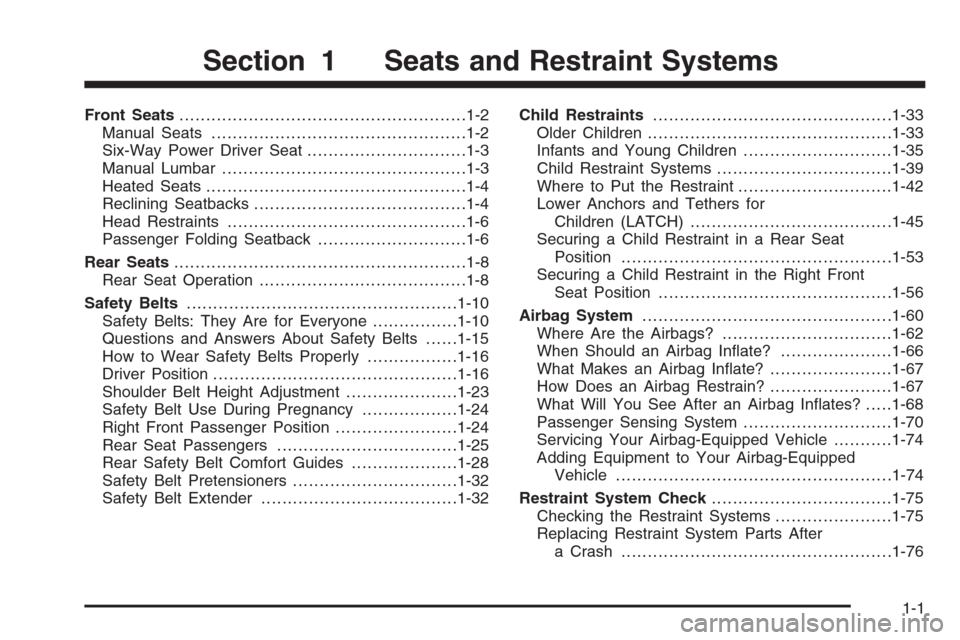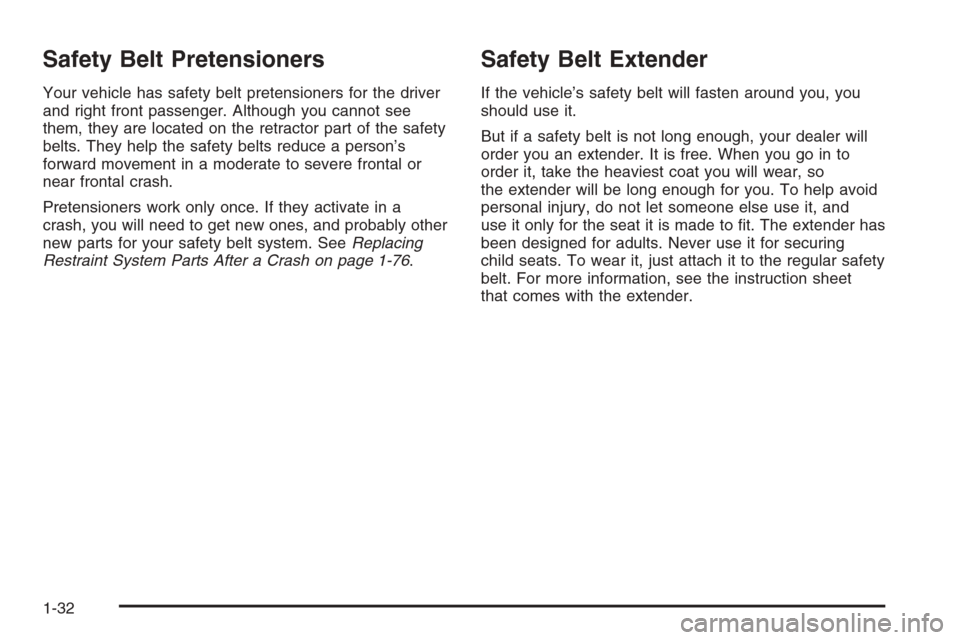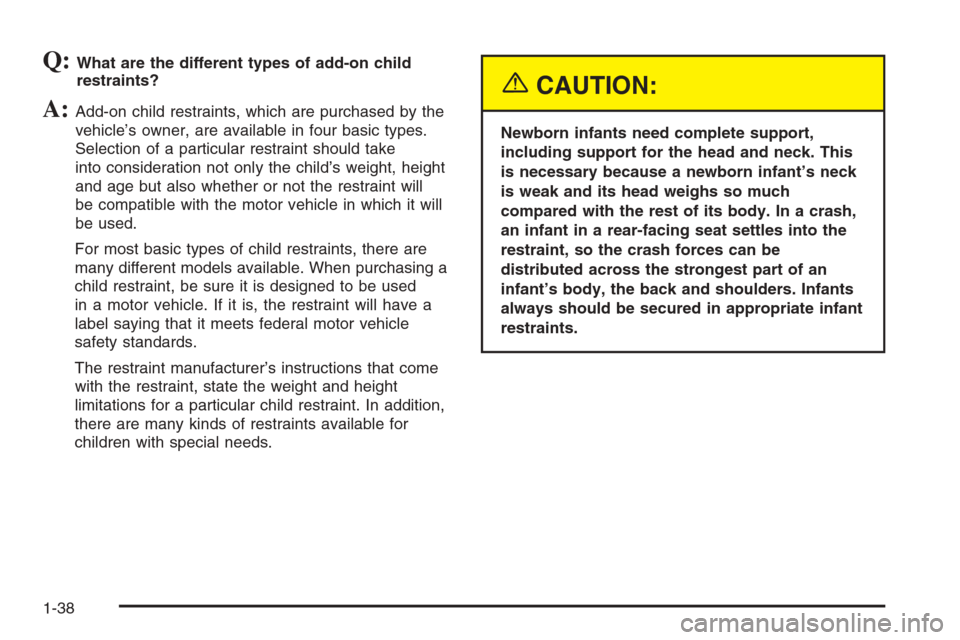Page 7 of 434

Front Seats......................................................1-2
Manual Seats................................................1-2
Six-Way Power Driver Seat..............................1-3
Manual Lumbar..............................................1-3
Heated Seats.................................................1-4
Reclining Seatbacks........................................1-4
Head Restraints.............................................1-6
Passenger Folding Seatback............................1-6
Rear Seats.......................................................1-8
Rear Seat Operation.......................................1-8
Safety Belts...................................................1-10
Safety Belts: They Are for Everyone................1-10
Questions and Answers About Safety Belts......1-15
How to Wear Safety Belts Properly.................1-16
Driver Position..............................................1-16
Shoulder Belt Height Adjustment.....................1-23
Safety Belt Use During Pregnancy..................1-24
Right Front Passenger Position.......................1-24
Rear Seat Passengers..................................1-25
Rear Safety Belt Comfort Guides....................1-28
Safety Belt Pretensioners...............................1-32
Safety Belt Extender.....................................1-32Child Restraints.............................................1-33
Older Children..............................................1-33
Infants and Young Children............................1-35
Child Restraint Systems.................................1-39
Where to Put the Restraint.............................1-42
Lower Anchors and Tethers for
Children (LATCH)......................................1-45
Securing a Child Restraint in a Rear Seat
Position...................................................1-53
Securing a Child Restraint in the Right Front
Seat Position............................................1-56
Airbag System...............................................1-60
Where Are the Airbags?................................1-62
When Should an Airbag In�ate?.....................1-66
What Makes an Airbag In�ate?.......................1-67
How Does an Airbag Restrain?.......................1-67
What Will You See After an Airbag In�ates?.....1-68
Passenger Sensing System............................1-70
Servicing Your Airbag-Equipped Vehicle...........1-74
Adding Equipment to Your Airbag-Equipped
Vehicle....................................................1-74
Restraint System Check..................................1-75
Checking the Restraint Systems......................1-75
Replacing Restraint System Parts After
a Crash...................................................1-76
Section 1 Seats and Restraint Systems
1-1
Page 12 of 434
Head Restraints
The head restraints on both the front and rear seats are
adjustable. Press the button on the side of the post
to adjust the head restraint. Slide the head restraint up
or down so that the top of the restraint is closest to
the top of your head. This position reduces the chance
of a neck injury in a crash.
Passenger Folding Seatback
{CAUTION:
If you fold the seatback forward to carry longer
objects, such as skis, be sure any such cargo
is not near an airbag. In a crash, an in�ating
airbag might force that object toward a person.
This could cause severe injury or even death.
Secure objects away from the area in which an
airbag would in�ate. For more information, see
Where Are the Airbags? on page 1-62and
Loading Your Vehicle on page 4-29.
{CAUTION:
Things you put on this seatback can strike and
injure people in a sudden stop or turn, or in a
crash. Remove or secure all items before
driving.
1-6
Page 15 of 434
2. Once a lever is pulled, the seatback can be pushed
into the down position.
{CAUTION:
If the seatback is not locked, it could move
forward in a sudden stop or crash. That could
cause injury to the person sitting there. Always
press rearward on the seatback to be sure it is
locked.
{CAUTION:
A safety belt that is improperly routed, not
properly attached, or twisted will not provide
the protection needed in a crash. The person
wearing the belt could be seriously injured.
After raising the rear seatback, always check
to be sure that the safety belts are properly
routed and attached, and are not twisted.
To return the seatback to the upright position, push the
seatback up until you hear a click. Then pull on the
seatback to make sure it is secure.
1-9
Page 23 of 434
If the belt stops before it reaches the buckle, tilt the
latch plate and keep pulling until you can buckle
the belt.
Pull up on the latch plate to make sure it is secure.
If the belt is not long enough, seeSafety Belt
Extender on page 1-32.
Make sure the release button on the buckle is
positioned so you would be able to unbuckle the
safety belt quickly if you ever had to.
5. Move the shoulder belt height adjuster to the height
that is right for you. SeeShoulder Belt Height
Adjustment on page 1-23.6. To make the lap part tight, pull down on the buckle
end of the belt as you pull up on the shoulder belt.
1-17
Page 32 of 434
If the belt stops before it reaches the buckle, tilt the
latch plate and keep pulling until you can buckle it.
Pull up on the latch plate to make sure it is secure.
If the belt is not long enough, seeSafety Belt
Extender on page 1-32.
Make sure the release button on the buckle is
positioned so you would be able to unbuckle the
safety belt quickly if you ever had to.3. To make the lap part tight, pull down on the buckle
end of the belt as you pull up on the shoulder part.
1-26
Page 38 of 434

Safety Belt Pretensioners
Your vehicle has safety belt pretensioners for the driver
and right front passenger. Although you cannot see
them, they are located on the retractor part of the safety
belts. They help the safety belts reduce a person’s
forward movement in a moderate to severe frontal or
near frontal crash.
Pretensioners work only once. If they activate in a
crash, you will need to get new ones, and probably other
new parts for your safety belt system. SeeReplacing
Restraint System Parts After a Crash on page 1-76.
Safety Belt Extender
If the vehicle’s safety belt will fasten around you, you
should use it.
But if a safety belt is not long enough, your dealer will
order you an extender. It is free. When you go in to
order it, take the heaviest coat you will wear, so
the extender will be long enough for you. To help avoid
personal injury, do not let someone else use it, and
use it only for the seat it is made to �t. The extender has
been designed for adults. Never use it for securing
child seats. To wear it, just attach it to the regular safety
belt. For more information, see the instruction sheet
that comes with the extender.
1-32
Page 42 of 434
{CAUTION:
People should never hold a baby in their arms
while riding in a vehicle. A baby does not
weigh much — until a crash. During a crash a
baby will become so heavy it is not possible to
hold it. For example, in a crash at only 25 mph
(40 km/h), a 12 lb (5.5 kg) baby will suddenly
become a 240 lb (110 kg) force on a person’s
arms. A baby should be secured in an
appropriate restraint.
1-36
Page 44 of 434

Q:What are the different types of add-on child
restraints?
A:Add-on child restraints, which are purchased by the
vehicle’s owner, are available in four basic types.
Selection of a particular restraint should take
into consideration not only the child’s weight, height
and age but also whether or not the restraint will
be compatible with the motor vehicle in which it will
be used.
For most basic types of child restraints, there are
many different models available. When purchasing a
child restraint, be sure it is designed to be used
in a motor vehicle. If it is, the restraint will have a
label saying that it meets federal motor vehicle
safety standards.
The restraint manufacturer’s instructions that come
with the restraint, state the weight and height
limitations for a particular child restraint. In addition,
there are many kinds of restraints available for
children with special needs.
{CAUTION:
Newborn infants need complete support,
including support for the head and neck. This
is necessary because a newborn infant’s neck
is weak and its head weighs so much
compared with the rest of its body. In a crash,
an infant in a rear-facing seat settles into the
restraint, so the crash forces can be
distributed across the strongest part of an
infant’s body, the back and shoulders. Infants
always should be secured in appropriate infant
restraints.
1-38